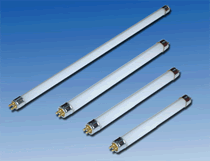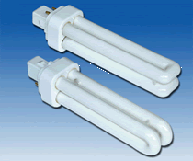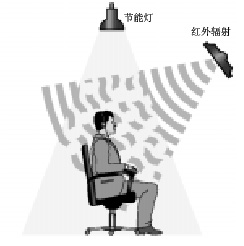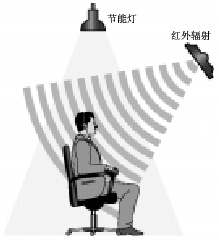First, the working principle of energy-saving lamps
The energy-saving lamp is also called compact fluorescent lamp (referred to as CFL lamp in foreign countries). It was first invented by foreign manufacturers in 1978. Because it has high luminous efficiency (5 times that of ordinary light bulb), it has obvious energy-saving effect and long life (it is ordinary light bulb). 8 times), small size, easy to use, etc., has been valued and welcomed by people and countries.
The energy-saving lamp mainly heats the filament of the lamp through the ballast. At about 1160K, the filament starts to emit electrons (because some electron powder is coated on the filament), and the electron collides with the argon atom to produce an inelastic collision. After the argon atom collides, the argon atom collides. The energy is absorbed and hits the mercury atom. The mercury atom breaks and generates ionization after absorbing energy. It emits 253.7nm ultraviolet light, and the ultraviolet light excites the phosphor to emit light. The temperature of the filament is about 1160K when the fluorescent lamp works, and the temperature is 2200K-2700K than that of the incandescent lamp. It is much lower, so its life is also greatly improved, reaching more than 5,000 hours. Because it does not have the current thermal effect like incandescent lamps, the energy conversion efficiency of the phosphor is also very high, reaching more than 50 lumens per watt. A 7-watt tri-color energy-saving lamp is equivalent to a 45-watt incandescent lamp, and has a lifespan eight times that of an ordinary incandescent bulb.


Various energy saving lamps
Second, the application prospects of energy-saving lamps
Electricity is the light of mankind, the foundation of all things, and everyone is saving the country and benefiting the people. According to the calculations of relevant departments in China, if all the ordinary lighting can be changed to energy-saving lighting, it will save more than 90 billion kilowatt-hours of electricity per year for the country, which is equivalent to the power generation of the Yangtze River Gezhouba Hydropower Station in 1994, which is 15.752 billion kWh. Times.
In 1982, China first developed the SL-type compact fluorescent lamp at the Institute of Electric Light Sources of Fudan University. Over the past 20 years, the output has grown rapidly and the quality has steadily improved. The country has already implemented it as a "green lighting project" during the "Ninth Five-Year Plan" period. The focus is on promoting products.
Third, the impact of energy-saving lamp source interference harmonics on infrared simultaneous interpretation system
Ordinary fluorescent lamps because their magnetic ballasts operate at a low frequency of 50 Hz, so the flashing of light is what the human eye can feel. To overcome this shortcoming, the energy-saving lamp electronic ballast converts the 50 Hz power supply to a high frequency of approximately 38 kHz, thus reducing the flashing of the light to an undetectable level. When the high frequency electronic ballast is operated, harmonics are generated due to the non-linear load making the current waveform not a sine wave. So what is harmonics? Harmonic is the Fourier series decomposition of periodic non-sinusoidal electric energy. In addition to obtaining the same component as the fundamental frequency, a series of components larger than the fundamental frequency are obtained. This part of the electric quantity is called harmonic. The ratio of the harmonic frequency to the fundamental frequency (n = fn / f1) is called the harmonic order. Harmonics are actually an amount of interference. The distortion of the current waveform as shown in the figure below is decomposed to obtain 1-Nth harmonic.

Since the high-frequency electronic ballast current of the energy-saving lamp generates interference harmonics of 1-N times the signal frequency, the light source driven by it also generates interference harmonics of 1-N times the signal frequency, as shown in the following figure:

The energy-saving lamp interferes with the harmonic energy at the frequency of 38kHZ, but the energy attenuation is close to zero as the frequency increases. At present, the infrared language distribution system manufactured by most conference system manufacturers on the market uses 45K-1MHz narrowband communication band to transmit language signals, while the frequency point of energy-saving lamps interfering with harmonics falls within the 45K-1MHz narrowband communication band, which will seriously affect The sound quality and communication distance of the infrared communication system.
At present, the best infrared language distribution system uses 2MHz-6MHz broadband communication band to transmit language signals, which effectively avoids harmonic interference generated by energy-saving lamps, and has the advantages of good transmission performance, good anti-interference performance and good sound quality and fidelity effect.


Editor: China Lighting Network Leaves
Industrial Fast Ethernet Switch is 10/100Base-TX to 100Base-FX Industrial Fast Ethernet Ethernet Switch. It will extend transmission distance of network up to 120Km via fiber port, and the UTP port can operate at 10M or 100M application.
industrial Fast Ethernet Switch is packaged in a compact IP40 case that allows either DIN rail or panel mounting for efficient usage of cabinet space. It accepts an integrated power supply with a wide range of voltages for worldwide operation. It can also be equipped dual-redundant, reversible polarity 12V DC to 48V DC power supply inputs for high availability applications requiring dual or backup power inputs.
Industrial Fast Ethernet Switch
Industrial Fast Ethernet Switch,Mini Industrial Ethernet Switch,Industrial Fast Network Switch, Industrial Ethernet Switch Din Rail Mount, Industrial Slim Type Fast Switch, Industrial 10/100M Ethernet Switch
Shenzhen N-net Technology Co.,Ltd , http://www.nnetswitch.com
